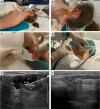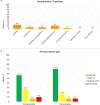Safety, patient acceptance and diagnostic accuracy of ultrasound core needle biopsy of parotid or submandibular glands in primary Sjögren's syndrome with suspected salivary gland lymphoma
- PMID: 35131750
- PMCID: PMC8823241
- DOI: 10.1136/rmdopen-2021-001901
Safety, patient acceptance and diagnostic accuracy of ultrasound core needle biopsy of parotid or submandibular glands in primary Sjögren's syndrome with suspected salivary gland lymphoma
Erratum in
-
Correction: Safety, patient acceptance and diagnostic accuracy of ultrasound core needle biopsy of parotid or submandibular glands in primary Sjögren's syndrome with suspected salivary gland lymphoma.RMD Open. 2022 Mar;8(1):e001901corr1. doi: 10.1136/rmdopen-2021-001901corr1. RMD Open. 2022. PMID: 35256535 Free PMC article. No abstract available.
Abstract
Background: Enlargement of the major salivary glands (SGs) is a major risk factor for B-cell lymphoma among patients with primary Sjögren's syndrome (pSS). Ultrasound-guided core needle biopsy (US-guided CNB) could be a novel technique to manage SG enlargement among patients with pSS.
Objective: Accordingly, this study's main aim was to evaluate the safety, patient tolerance and diagnostic accuracy of US-guided CNB procedure for patients with pSS with major SG enlargement.
Methods: Patients with clinical diagnosis of pSS and a clinical indication for SG biopsy consecutively underwent US-guided CNB between September 2019 and June 2021. These patients were evaluated clinically 1, 2 and 12 weeks after US-guided CNB. Patients were asked to complete a questionnaire about postprocedural complications as well as periprocedural pain, using the Visual Analogue Scale. Complications were categorised as transient (<12 weeks) or persistent (≥12 weeks).
Results: US-guided CNB was performed on 30 major salivary glands (22 parotid glands and 8 submandibular glands). The procedure was well tolerated. Transient complications-such as haematoma, swelling-were observed among 43% of patients, and mean periprocedural pain was low. However, no persistent complications were reported during the study's follow-up period.
Conclusion: US-guided CNB represents a novel approach for the management of patients with pSS with SG enlargement. The procedure showed remarkable patient safety and tolerance, allowing adequate glandular sampling and a definite diagnosis for almost all participating patients without long-term complications.
Keywords: Sjogren's syndrome; autoimmune diseases; ultrasonography.
© Author(s) (or their employer(s)) 2022. Re-use permitted under CC BY-NC. No commercial re-use. See rights and permissions. Published by BMJ.
Conflict of interest statement
Competing interests: None declared.
Figures




Similar articles
-
Ultrasound-guided core needle biopsy compared with open biopsy: a new diagnostic approach to salivary gland enlargement in Sjögren's syndrome?Rheumatology (Oxford). 2021 Mar 2;60(3):1282-1290. doi: 10.1093/rheumatology/keaa441. Rheumatology (Oxford). 2021. PMID: 32940706
-
Ultrasound-Guided Biopsy of Suspected Salivary Gland Lymphoma in Sjögren's Syndrome.Arthritis Care Res (Hoboken). 2021 Jun;73(6):849-855. doi: 10.1002/acr.24203. Arthritis Care Res (Hoboken). 2021. PMID: 32248649 Free PMC article.
-
Usefulness of ultrasound guided core needle biopsy of the parotid gland for the diagnosis of primary Sjögren's syndrome.Clin Exp Rheumatol. 2022 Dec;40(12):2381-2386. doi: 10.55563/clinexprheumatol/5n49yj. Epub 2022 Nov 21. Clin Exp Rheumatol. 2022. PMID: 36441652
-
Ultrasound and Bioptic Investigation of Patients with Primary Sjögren's Syndrome.J Clin Med. 2021 Mar 11;10(6):1171. doi: 10.3390/jcm10061171. J Clin Med. 2021. PMID: 33799655 Free PMC article. Review.
-
Nuts and bolts of salivary gland pathology in primary Sjögren's syndrome.Clin Exp Rheumatol. 2023 Dec;41(12):2525-2537. doi: 10.55563/clinexprheumatol/fcjoqx. Epub 2023 Nov 29. Clin Exp Rheumatol. 2023. PMID: 38079343 Review.
Cited by
-
Sjögren's Syndrome: Epidemiology, Classification Criteria, Molecular Pathogenesis, Diagnosis, and Treatment.MedComm (2020). 2025 Jul 11;6(7):e70297. doi: 10.1002/mco2.70297. eCollection 2025 Jul. MedComm (2020). 2025. PMID: 40656544 Free PMC article. Review.
-
Salivary Gland Ultrasound in Primary Sjögren's Syndrome: Current and Future Perspectives.Open Access Rheumatol. 2022 Sep 1;14:147-160. doi: 10.2147/OARRR.S284763. eCollection 2022. Open Access Rheumatol. 2022. PMID: 36072437 Free PMC article. Review.
-
The agreement of the OMERACT grey-scale ultrasound scoring system for salivary glands and minor salivary gland biopsy results in a single-center cohort of patients with suspected Sjögren's disease.Skeletal Radiol. 2025 Feb 10. doi: 10.1007/s00256-025-04885-7. Online ahead of print. Skeletal Radiol. 2025. PMID: 39930126
-
Lymphomas affecting the submandibular glands.Med Oral Patol Oral Cir Bucal. 2024 Jan 1;29(1):e78-e86. doi: 10.4317/medoral.26065. Med Oral Patol Oral Cir Bucal. 2024. PMID: 37471301 Free PMC article.
-
Sonographic Appearance of Lacrimal Glands in Sjögren's Syndrome at High Risk for Lymphoma Development.Cureus. 2023 Dec 6;15(12):e50047. doi: 10.7759/cureus.50047. eCollection 2023 Dec. Cureus. 2023. PMID: 38077662 Free PMC article.
References
MeSH terms
LinkOut - more resources
Full Text Sources
Medical
